Analysis of Aluminum Oxides Submicron Particle Agglomeration in Polymethyl Methacrylate Composites
Abstract
1. Introduction
2. Results
3. Discussion
- A decrease in the number and size of agglomerates due to an increase in PMMA melt viscosity while particles concentration increases;
- An increase in the number and size of agglomerates while particles concentration increases due to an increase in the number of particle collisions, including inelastic collisions [27].
4. Materials and Methods
4.1. Materials and Their Properties
4.2. Methods
4.2.1. Al2O3 Particles Coating
4.2.2. Analysis of the Agglomerates
4.2.3. A Method for Measurement of Optical Properties
5. Conclusions
Author Contributions
Funding
Institutional Review Board Statement
Informed Consent Statement
Data Availability Statement
Conflicts of Interest
References
- Tarasov, A.E.; Badamshina, E.R.; Anokhin, D.V.; Razorenov, S.V.; Vakorina, G.S. The effect of small additions of carbon nanotubes on the mechanical properties of epoxy polymers under static and dynamic loads. Tech. Phys. 2018, 63, 32–40. [Google Scholar] [CrossRef]
- Aderikha, V.N.; Shapovalov, V.A.; Pleskachevskiy, Y.M. Strength characteristics, structure and wear resistance of PTFE-commercial carbon composites. J. Frict. Wear 2008, 29, 120–126. [Google Scholar] [CrossRef]
- Sheinerman, A.G.; Krasnitskii, S.A. Modeling of the influence of graphene agglomeration on the mechanical properties of ceramic composites with graphene. Tech. Phys. Lett. 2021, 47, 873–876. [Google Scholar] [CrossRef]
- Hill, D.; Barron, A.R.; Shirin, A. Comparison of hydrophobicity and durability of functionalized aluminium oxide nanoparticle coatings with magnetite nanoparticles–links between morphology and wettability. J. Colloid Interf. Sci. 2019, 555, 323–330. [Google Scholar] [CrossRef]
- Berezhnoj, Y.M.; Lipkin, V.M.; Skorikov, A.V.; Derlugyan, P.D.; Shishka, V.G.; Danyushina, G.A.; Lipkin, S.M. Effect of ultrafine copper powders, stabilized by water soluble polymers on composite materials properties. Injenerniy Vestn. Dona 2015, 3. [Google Scholar]
- Pykhtin, A.A.; Simonov-Emelyanov, I.D. Effect of nano and ultradispersed silica particles (SiO2) on the impact strength of epoxy polymers. Tr. VIAM 2019, 6, 3–12. [Google Scholar] [CrossRef]
- Pakdel, A.; Bando, Y.; Golberg, D. Plasma-Assisted Interface Engineering of Boron Nitride Nanostructure Films. ACS Nano 2014, 8, 10631–10639. [Google Scholar] [CrossRef] [PubMed]
- Vengatesan, M.R.; Mittal, V. Surface Modification of Nanoparticle and Natural Fiber Fillers; Mittal, V., Ed.; Wiley: Weinheim, Germany; VCH Verlag GmbH: Weinheim, Germany; Co. KGaA: Weinheim, Germany, 2015; ISBN 978-3-527-67026-0. [Google Scholar] [CrossRef]
- Danilaev, M.P.; Drobyshev, S.V.; Klabukov, M.A.; Kuklin, V.A.; Mironova, D.A. Formation of a polymer shell of a given thickness on surfaces of submicronic particles. Nanobiotechnol. Rep. 2021, 16, 162–166. [Google Scholar] [CrossRef]
- Akhmadeev, A.A.; Bogoslov, E.A.; Danilaev, M.P.; Klabukov, M.A.; Kuklin, V.A. Influence of the thickness of a polymer shell applied to surfaces of submicron filler particles on the properties of polymer compositions. Mech. Compos. Mater. 2020, 56, 241–248. [Google Scholar] [CrossRef]
- Buyanov, I.A. Development of technology to introduce carbon nanotubes into a polyester-binder composition. Polym. Sci. Ser. D 2013, 6, 160–163. [Google Scholar] [CrossRef]
- Revo, S.L.; Avramenko, T.G.; Melnichenko, M.M.; Ivanenko, K.O. Mechanical characteristics of nanocomposite materials based on polytrifluorochloroethylene. Mol. Cryst. Liq. Cryst. 2022, 748, 82–89. [Google Scholar] [CrossRef]
- Dal Lago, E.; Cagnin, E.; Boaretti, C.; Roso, M.; Lorenzetti, A.; Modesti, M. Influence of different carbon-based fillers on electrical and mechanical properties of a PC/ABS blend. Polymers 2019, 12, 29. [Google Scholar] [CrossRef] [PubMed]
- Sanya, O.T.; Oji, B.; Owoeye, S.S.; Egbochie, E.J. Influence of particle size and particle loading on mechanical properties of silicon carbide–reinforced epoxy composites. Int. J. Adv. Manuf. Technol. 2019, 103, 4787–4794. [Google Scholar] [CrossRef]
- Melo, P.M.A.; Macêdo, O.B.; Barbosa, G.P.; Ueki, M.M.; Silva, L.B. High-density polyethylene/mollusk shell-waste composites: Effects of particle size and coupling agent on morphology, mechanical and thermal properties. J. Mater. Res. Technol. 2019, 8, 1915–1925. [Google Scholar] [CrossRef]
- Senthil Muthu Kumar, T.; Senthilkumar, K.; Chandrasekar, M.; Subramaniam, S.; Mavinkere Rangappa, S.; Siengchin, S.; Rajini, N. Influence of fillers on the thermal and mechanical properties of biocomposites: An overview. In Biofibers and Biopolymers for Biocomposites; Springer: Berlin/Heidelberg, Germany, 2020; pp. 111–133. [Google Scholar] [CrossRef]
- Rani, G.E.; Murugeswari, R.; Siengchin, S.; Rajini, N.; Kumar, M.A. Quantitative assessment of particle dispersion in polymeric composites and its effect on mechanical properties. J. Mater. Res. Technol. 2022, 19, 1836–1845. [Google Scholar] [CrossRef]
- Samal, S. Effect of shape and size of filler particle on the aggregation and sedimentation behavior of the polymer composite. Powder Technol. 2020, 366, 43–51. [Google Scholar] [CrossRef]
- Tyson, B.M.; Al-Rub, R.K.A.; Yazdanbakhsh, A.; Grasley, Z. A quantitative method for analyzing the dispersion and agglomeration of nano-particles in composite materials. Compos. Part B-Eng. 2011, 42, 1395–1403. [Google Scholar] [CrossRef]
- Kuo, S.L.; Chen, Y.C.; Ger, M.D.; Hwu, W.H. Nano-particles dispersion effect on Ni/Al2O3 composite coatings. Mater. Chem. Phys. 2004, 86, 5–10. [Google Scholar] [CrossRef]
- Lelischev, Y.G.; Val’tsifer, V.A.; Strel’nikov, V.N.; Astaf’eva, S.A.; Vasil’ev, O.G. A study of microstructural formations of ultrafine particles in liquid oligomer composites. Khimicheskaya Promyshlennost’ Segodnya 2009, 3, 33–39. [Google Scholar]
- Mukabenova, B.E.; Nikolaev, N.E.; Chekhlova, T.K. Influence of agglomerate formation on spectral properties of composite media. In Proceedings of the LVI All-Russia Conference on Problems in Dynamics, Particle Physics, Plasma Physics and Optoelectronics, RUDN University, Moscow, Russia, 18–22 May 2020; pp. 192–196. [Google Scholar]
- Lavrent’ev, M.M.; Romanov, V.G.; Shishatskiy, S.P. Ill-Posed Problems in Mathematical Physics and Analysis; Nauka Publishing House: Moscow, Russia, 1980. [Google Scholar]
- Sakhabutdinov, A.Z.; Hussein, S.M.R.H.; Ibragimova, A.R.; Kuklin, V.; Danilaev, M.P.; Zaharova, L.Y. Polystyrene Molecular Weight Determination of Submicron Particles Shell. Karbala Int. J. Mod. Sci. 2021, 7, 234–240. [Google Scholar] [CrossRef]
- Orlikovsky, N.A.; Rau, E.I. Image contrast in the backscattered electron mode in scanning electron microscopy and microtomography. Bull. Russ. Acad. Sci. 2011, 75, 1234–1239. [Google Scholar] [CrossRef]
- Danilaev, M.P.; Karandashov, S.A.; Kuklin, A.Z.; Hussein, S.M.R.H. Turbidimetric photometer for studying the sedimentation of nanosized objects. Nauchnoe Priborostr. 2021, 31, 35–43. [Google Scholar] [CrossRef]
- Amankulov, Y.; Agabekova, D. Dielectric properties of the polymers filled with ferrite particles. Evraziyskoe Nauchnoe Ob’edinenie 2018, 46, 52–57. [Google Scholar]
- Serenko, O.A.; Goncharuk, G.P.; Knunyants, M.I.; Kryuchkov, A.N. Flow of highly filled thermoplastic-dispersed elastic filler compositions. Polym. Sci. Ser. A 1998, 40, 746–750. [Google Scholar]
- Vaia, R.A.; Jandt, K.D.; Kramer, E.J.; Giannelis, E.P. Kinetics of polymer melt intercalation. Macromolecules 1995, 28, 8080–8085. [Google Scholar] [CrossRef]
- Losev, S.A.; Umanskii, S.Y.; Yakubov, I.T. Physics and Chemistry in Gas Dynamics. Computer-Assisted Guide in 3 Volumes; Tcherniy, G.G., Losev, S.A., Eds.; Moscow University Publishing House: Moscow, Russia, 1995. [Google Scholar] [CrossRef]
- Semchikov, Y.D. High Molecular Compounds; Lobachevsky University Publishing House: Nizhniy Novgorod, Russia; Akademiya Publishing Center: Nizhniy Novgorod, Russia, 2003. [Google Scholar]
- Bohren, C.F.; Huffman, D.R. Absorption and Scattering of Light by Small Particles; Mir Publishing House: Moscow, Russia, 1986. [Google Scholar]
- Lock, J.A.; Laven, P. Understanding light scattering by a coated sphere. Part 2: Time domain analysis. J. Opt. Soc. Am. 2012, 29, 1498–1507. [Google Scholar] [CrossRef]
- Besperstov, I.V.; Frolov, I.I.; Pas’ko, A.A. A study of carbon nanotubes dispersion. In Proceedings of the IX International Academic and Research Contest, Vladivostok, Russia, 28–31 October 2016; Gulyaev, G.Y., Ed.; Nauka and Prosveschenie International Center for Cooperation in Research: Penza, Russia, 2017; pp. 55–59. [Google Scholar]
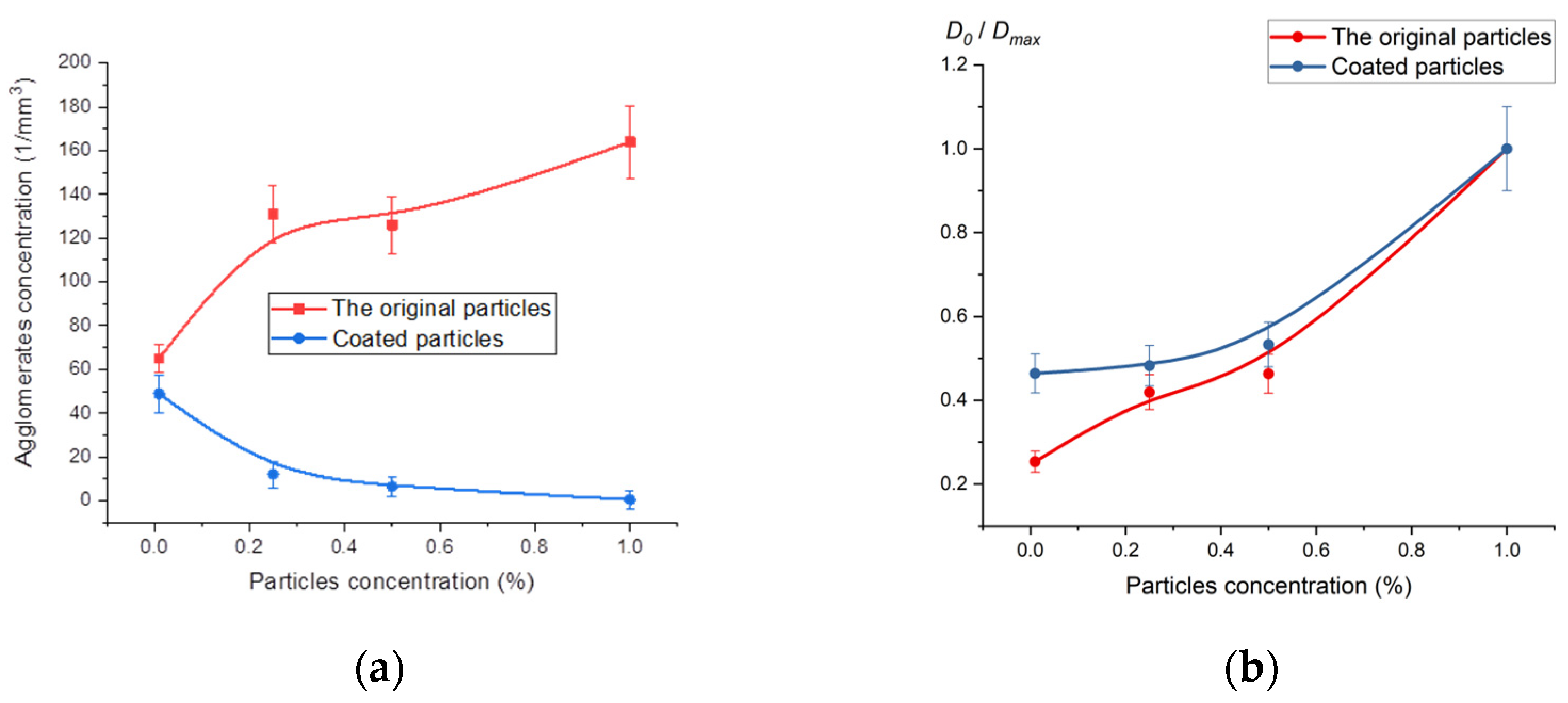
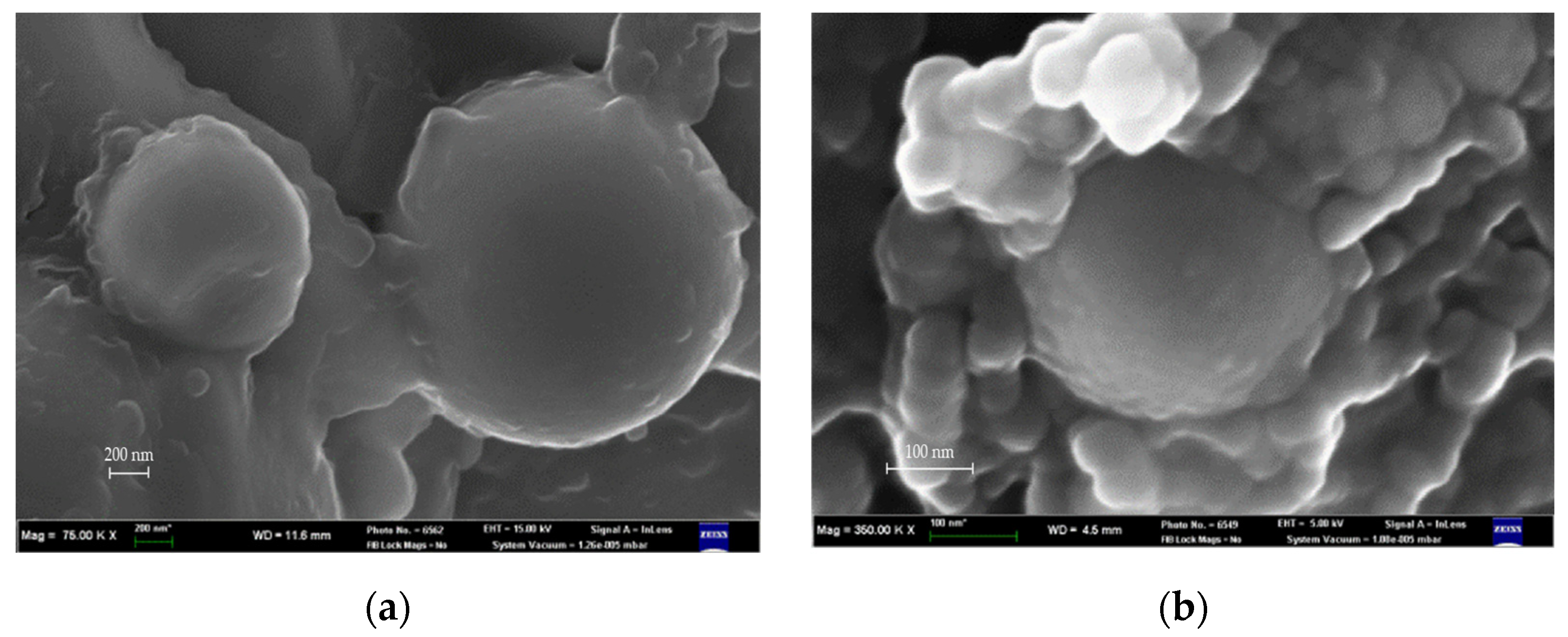

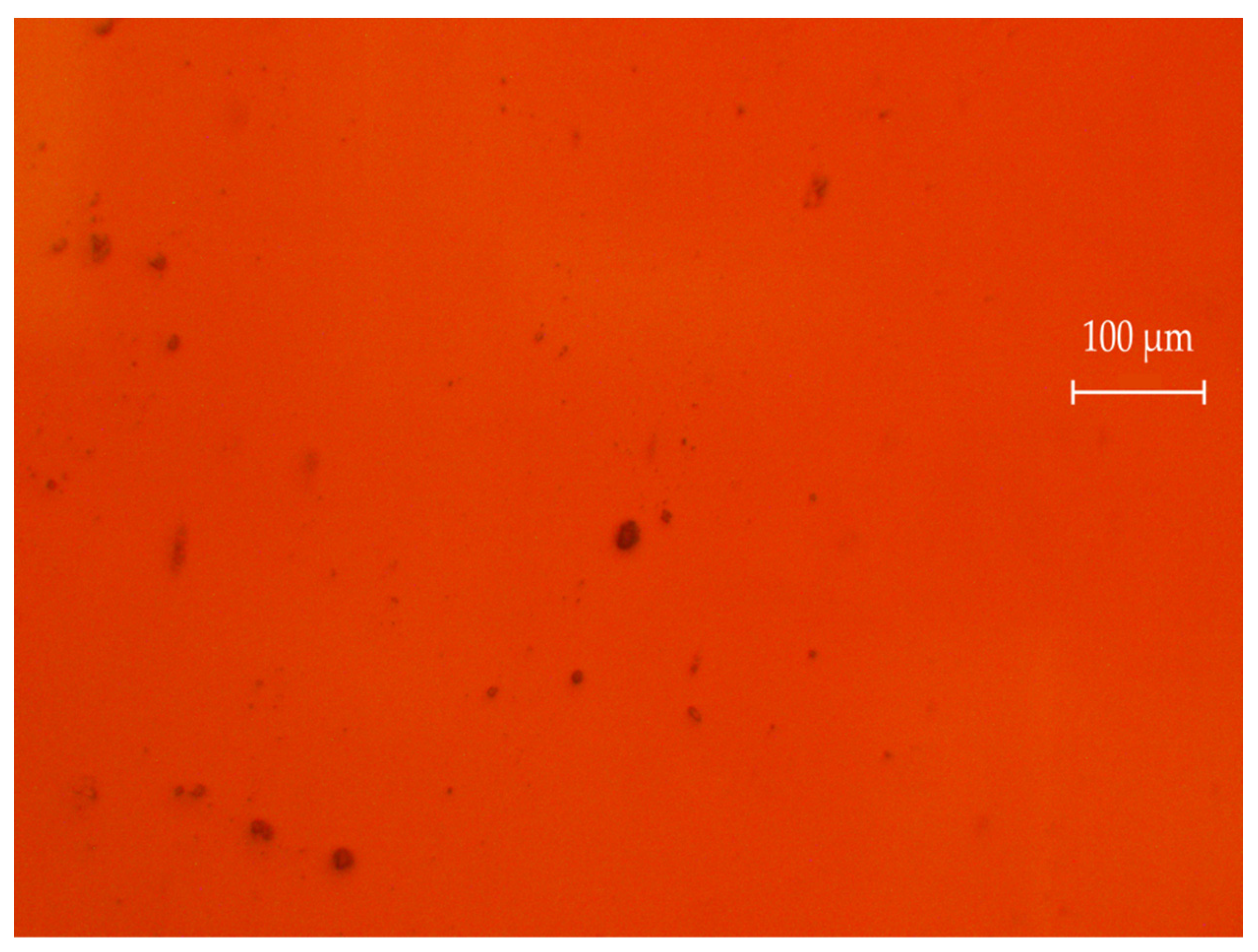
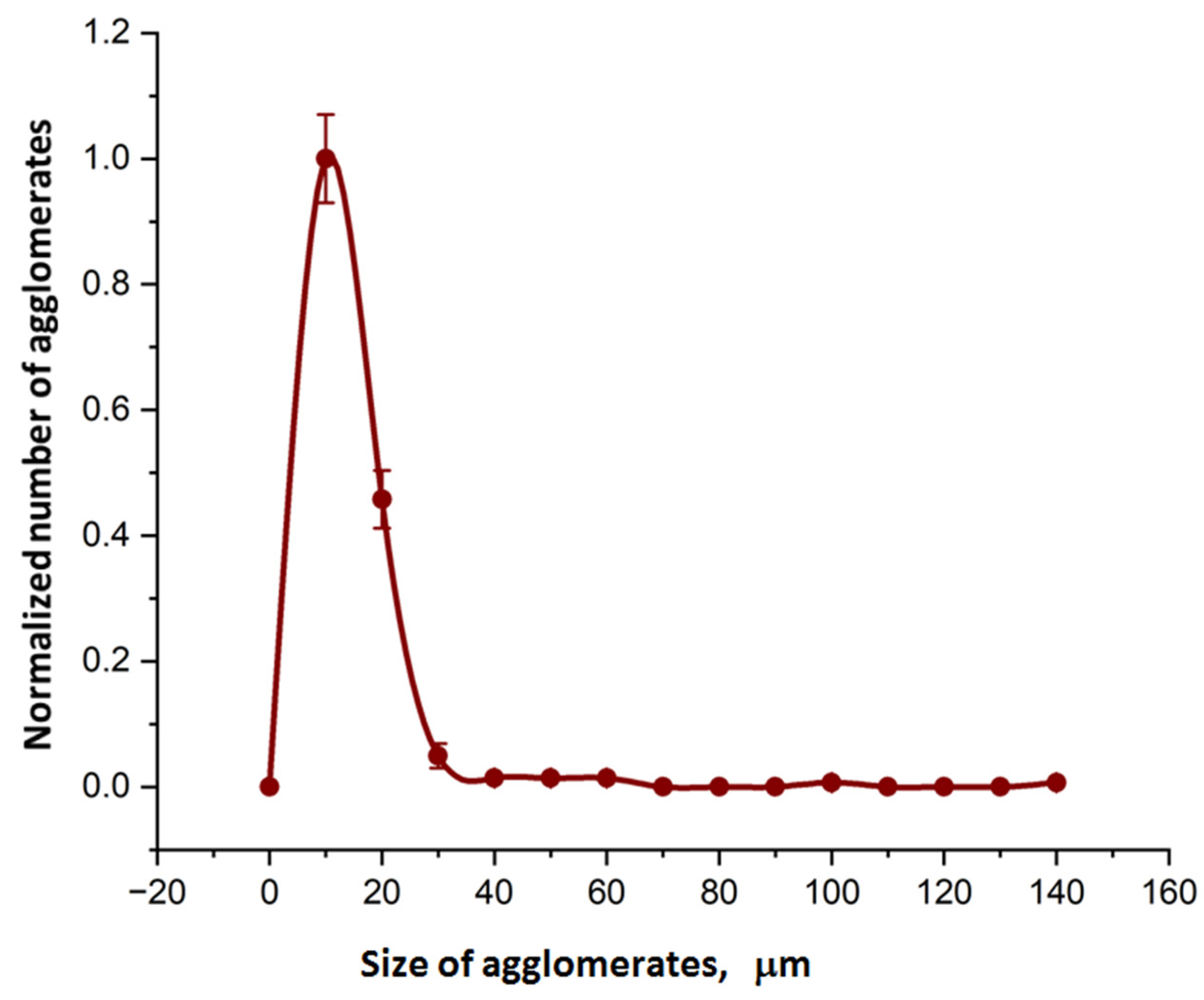
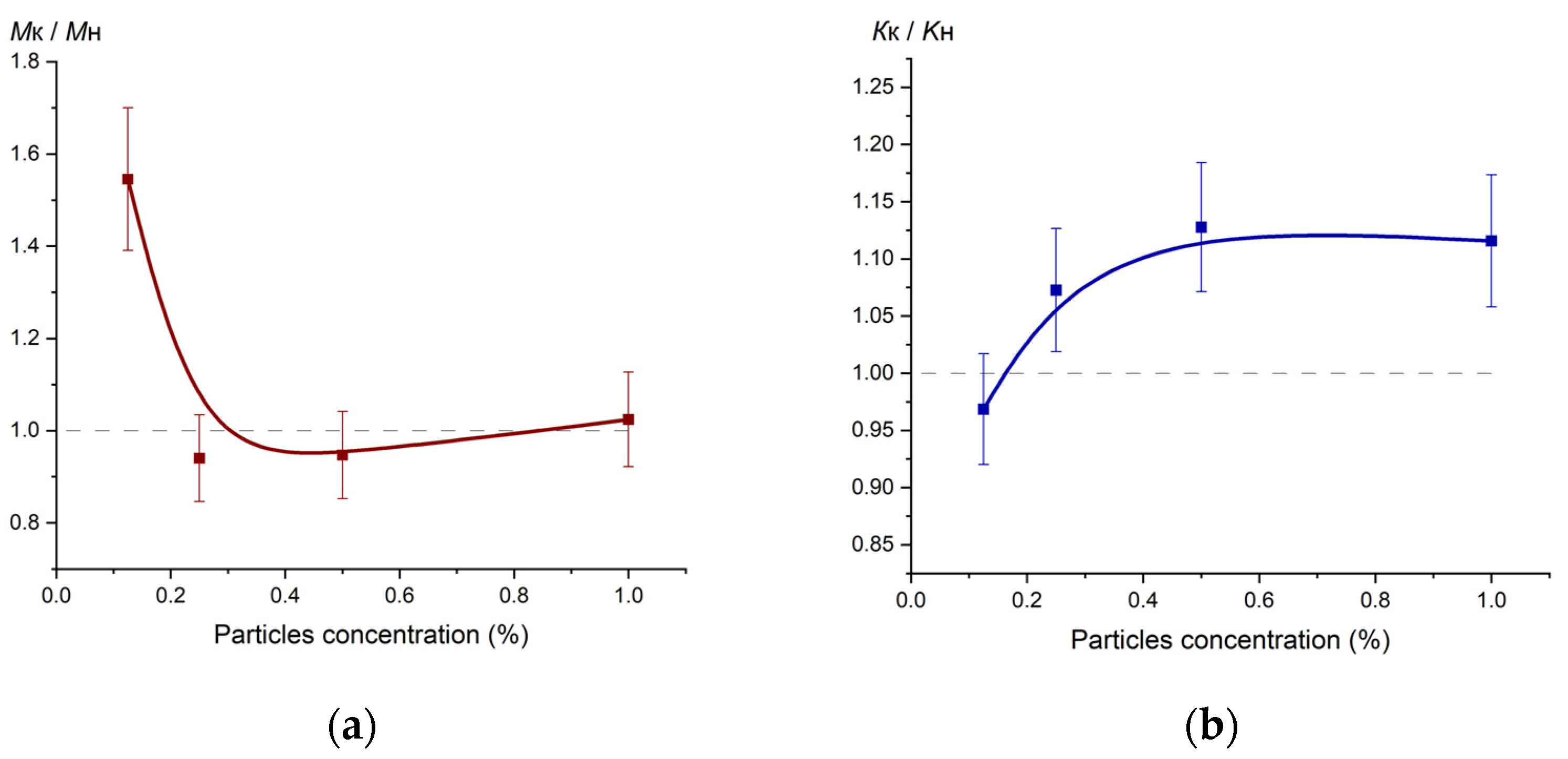
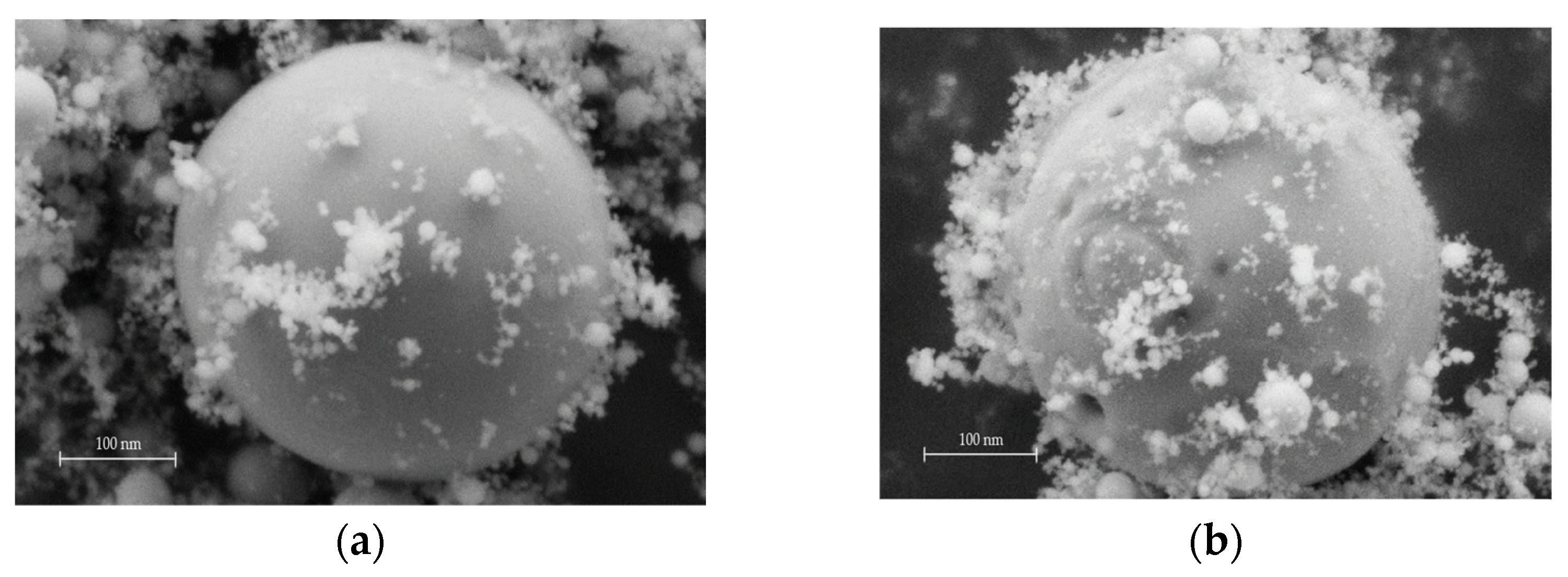
| Specimen Type | Polystyrene Coating? | Mass Concentration of Particles in the Specimen, % |
|---|---|---|
| Specimen 0 | No | 0 |
| Specimen 1.1 | No | 1 |
| Specimen 1.2 | No | 0.5 |
| Specimen 1.3 | No | 0.25 |
| Specimen 1.4 | No | 0.01 |
| Specimen 2.1 | Yes | 1 |
| Specimen 2.2 | Yes | 0.5 |
| Specimen 2.3 | Yes | 0.25 |
| Specimen 2.4 | Yes | 0.01 |
Disclaimer/Publisher’s Note: The statements, opinions and data contained in all publications are solely those of the individual author(s) and contributor(s) and not of MDPI and/or the editor(s). MDPI and/or the editor(s) disclaim responsibility for any injury to people or property resulting from any ideas, methods, instructions or products referred to in the content. |
© 2023 by the authors. Licensee MDPI, Basel, Switzerland. This article is an open access article distributed under the terms and conditions of the Creative Commons Attribution (CC BY) license (https://creativecommons.org/licenses/by/4.0/).
Share and Cite
Kuklin, V.; Karandashov, S.; Bobina, E.; Drobyshev, S.; Smirnova, A.; Morozov, O.; Danilaev, M. Analysis of Aluminum Oxides Submicron Particle Agglomeration in Polymethyl Methacrylate Composites. Int. J. Mol. Sci. 2023, 24, 2515. https://doi.org/10.3390/ijms24032515
Kuklin V, Karandashov S, Bobina E, Drobyshev S, Smirnova A, Morozov O, Danilaev M. Analysis of Aluminum Oxides Submicron Particle Agglomeration in Polymethyl Methacrylate Composites. International Journal of Molecular Sciences. 2023; 24(3):2515. https://doi.org/10.3390/ijms24032515
Chicago/Turabian StyleKuklin, Vladimir, Sergey Karandashov, Elena Bobina, Sergey Drobyshev, Anna Smirnova, Oleg Morozov, and Maxim Danilaev. 2023. "Analysis of Aluminum Oxides Submicron Particle Agglomeration in Polymethyl Methacrylate Composites" International Journal of Molecular Sciences 24, no. 3: 2515. https://doi.org/10.3390/ijms24032515
APA StyleKuklin, V., Karandashov, S., Bobina, E., Drobyshev, S., Smirnova, A., Morozov, O., & Danilaev, M. (2023). Analysis of Aluminum Oxides Submicron Particle Agglomeration in Polymethyl Methacrylate Composites. International Journal of Molecular Sciences, 24(3), 2515. https://doi.org/10.3390/ijms24032515







